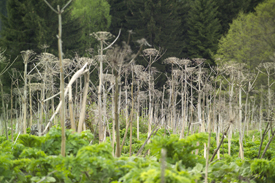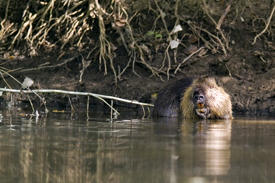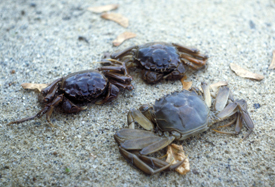Press release from April 22nd, 2009
Ecologists Put Price Tag on Invasive Species
- Research reports costs of invasive species’ damage to ecosystem services
Invasive species can disrupt natural and man-made ecosystems, throwing food webs out of balance and damaging the services they provide to humans. Now ecologists have begun to put a price tag on this damage. In a study published this week in Frontiers in Ecology and the Environment e-view, ecologists have listed the invasive species that cause the most harm to environment and cost the most money to combat.

The Giant Hogweed (Heracleum mantegazzianum) are up to four metres high. It can cause third-degree burns because of the extremely aggressive sap inside the plant.
Photo: André Künzelmann/UFZ

The nutria (Myocastor coypus) is considered a pest for its feeding on crops, such as sugar beets and maize, and for its burrowing activity that disrupts riverbanks and dikes. In Italy during 1995-2000, despite control activities involving the removal of 220,688 coypus with a cost of 2,614,408 €, damage to the riverbanks exceeded 10 million € and impact on agriculture reached 935,138 €.
Photo: André Künzelmann/UFZ

For example, commercial fisheries losses due to the Chinese mitten crab (Eriocheir sinensis) may range from €73.4-€84.7 million since 1912, as a result of intermittent mass occurrences in German waters. However, because the crabs are sold as food (amounting to sales of €3-€4.5 million between 1994 and 2004), this quantity needs to be deducted from impact costs arising from their burrowing activity, which erodes dikes and river and lake embankments.
Photo: Uta Dreyer/UFZ
"The impacts of many invaders go unnoticed, and our lives depend on the ecosystem services provided by species," says study lead author Montserrat Vilà of the Estación Biológica de Doñana in Seville, Spain. "The presence, and many times the dominance, of non-native species can cause many ecological impacts that translate to changes in ecosystem services. These changes can be irreversible, and many are as important as the changes caused by climate change or pollution."
Vilà and her colleagues present results on the more than 10,000 alien species known to exist in Europe. They used data from the Delivering Alien Invasive Species Inventories for Europe (DAISIE; http://www.europe-aliens.org/) project, which was commissioned by the EU in 2005 to survey invasive species across Europe and assess their ecological and economic impacts.
Ecosystem services are broken down into four categories: supporting major ecosystem resources, such as water and energy cycles; provisioning by producing goods, such as pollination of crops; regulating ecosystem processes, such as water filtration; and cultural or non-material benefits, such as recreation and aesthetics.
Vilà and her colleagues produced a list of the top 100 invasive species in Europe by assessing which species had the most impacts in the most categories. Among the top invaders were Canada geese, zebra mussels, brook trout, the Bermuda buttercup and coypu, also known as nutria. Terrestrial vertebrates produce the widest range of impacts, often showing effects in all of the ecosystem service categories. "Many terrestrial vertebrates are top predators, and their introduction causes cascading effects in the food web," Vilà says.
By contrast, terrestrial invertebrates such as insects and spiders had the narrowest range of effects, but wreaked the most financial havoc. Vilà points out that terrestrial invertebrates cause the most damage to crops and forests, sectors in which there are well-established methods to quantify the costs of food and lumber production. The authors estimate annual crop losses in the United Kingdom due to alien arthropods at €2.8 billion (about $3.7 billion), and the cost of eradicating the 30 most common weeds could be more than €150 million ($197 million).
The authors also report the alien species generating the highest reported financial investment, including costs of monitoring, controlling and eradicating the invader, along with environmental education programs. Among the most expensive invaders were water hyacinth (€3.4 /$4.5 million), coypu (€2.8/$3.7 million) and a marina alga (€8.2/$10.9 million).
The major issue for management of invasives, Vilà says, is the "unknown". Her study shows that in Europe, the impacts of only about 10 percent of invasive species are known to ecologists and economists. In addition, although the U.S. has done a lot on the ecological mechanisms on impact, it still lags behind Europe in creating an inventory of known invasive species.
Vilà’s team suggests that several existing U.S. assessments of invasive species and existing local and state databases would provide a good start for an inventory of the North American continent that could interface with DAISIE.
"We need to harmonize the existing information on impacts across species and across regions," Vilà says. "Then, finally, we will be able to create institutional bodies across sectors, such as agriculture, environment, health and transportation, to tackle the prevention and management of the impacts of biological invasions."
More Information:
Dr. Stefan Klotz/ Dr. Ingolf Kühn/ Dr. Marten Winter
Helmholtz Centre for Environmental Research (UFZ)
Phone +49-345 558-5302, -5311, -5316
http://www.ufz.de/index.php?de=14699
http://www.ufz.de/index.php?de=821
http://www.ufz.de/index.php?en=7081
and
Dr. Montserrat Vilà
Estación Biológica de Doñana, Sevilla, Spanien,
Phone: +34 954-232340-123
http://www.montsevila.org/
or
Tilo Arnhold (UFZ press officer)
Phone: +49-341-235-1269
presse@ufz.de
Publication:
Vila M, Basnou C, Pysek P, Josefsson M, Genovesi P, Gollasch S et al.
(2009): How well do we understand the impacts of alien species on
ecosystem services? A pan-European cross-taxa assessment. Frontiers in
Ecology and the Environment. doi: 10.1890/080083
http://www.esajournals.org/doi/abs/10.1890/080083
Links:
DAISIE (Delivering Alien Invasive Species Inventories for Europe):
http://www.europe-aliens.org/
Journal "Frontiers in Ecology and the Environment"
http://www.frontiersinecology.org/
Ecological Society of America (ESA):
http://www.esa.org/
At the Helmholtz Centre for Environmental Research (UFZ) scientists research the causes and consequences of far-reaching environmental changes. They study water resources, biological diversity, the consequences of climate change and adaptation possibilities, environmental and biotechnologies, bio energy, the behaviour of chemicals in the environment and their effect on health, as well as modelling and social science issues. Their guiding research principle is supporting the sustainable use of natural resources and helping to secure these basic requirements of life over the long term under the influence of global change. The UFZ employs 930 people at its sites in Leipzig, Halle and Magdeburg. It is funded by the German government and by the states of Saxony and Saxony-Anhalt.
The Helmholtz Association helps solve major, pressing challenges facing society, science and the economy with top scientific achievements in six research areas: Energy, Earth and Environment, Health, Key Technologies, Structure of Matter, Transport and Space. With 28,000 employees in 15 research centres and an annual budget of around EUR 2.4 billion, the Helmholtz Association is Germany’s largest scientific organisation. Its work follows in the tradition of the great natural scientist Hermann von Helmholtz (1821-1894)..
The Ecological Society of America (ESA) is the world’s largest professional organization of ecologists, representing 10,000 scientists in the United States and around the globe. Since its founding in 1915, ESA has promoted the responsible application of ecological principles to the solution of environmental problems through ESA reports, journals, research, and expert testimony to Congress. ESA publishes four journals and convenes an annual scientific conference.
